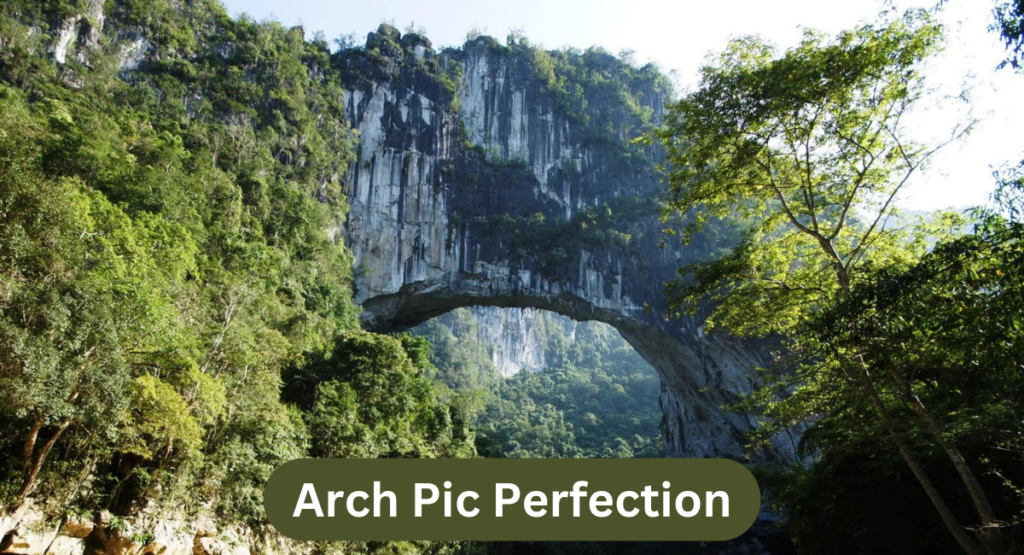In the world of Arch Pic photography, capturing the grandeur and beauty of natural landscapes is a pursuit that combines artistic vision with technical skill. One particularly captivating subject in this realm is the natural arch. These geological formations, sculpted over millennia, offer a stunning contrast against the sky and surrounding environment. “Arch Pic Perfection: The Art of Framing Natural Arches” delves into the techniques and strategies to master the art of photographing these magnificent structures.
Understanding Natural Arches
Natural arches are fascinating geological features formed by the erosive forces of wind, water, and ice. They appear as rock formations with an opening or span that allows one to see through them. Examples include the iconic Delicate Arch in Utah’s Arches National Park and the Rock Arch in Iceland. Each arch presents a unique challenge and opportunity for photographers aiming to capture its essence.

Why Focus on Arch Pic Perfection?
“Arch Pic Perfection” is not just about snapping a photo of an arch; it’s about understanding how to frame and photograph these structures to highlight their beauty and grandeur. Achieving perfection in arch photography requires a blend of technical expertise, creative vision, and a deep appreciation for the natural world. By focusing on arch pic perfection, photographers can elevate their work from mere snapshots to stunning visual representations of these natural wonders.
Choosing the Right Time and Light
One of the key elements in achieving arch pic perfection is selecting the optimal time for your shoot. Natural arches often look their best during the golden hours—shortly after sunrise and before sunset—when the light is soft and warm. The angle of the light can create dramatic shadows and highlight the textures of the rock.
Morning Light
Photographing an arch in the morning light can offer a serene and soft glow. Early morning shots are ideal for arches located in areas with harsh midday light. The cool tones and long shadows can enhance the texture and depth of the rock formation, contributing to a more nuanced and captivating image.
Evening Light
Conversely, the golden hour during sunset can provide a dramatic backdrop with rich, warm hues. The light’s angle can illuminate the arch’s structure and create a stunning contrast between the arch and the sky. Sunset shots often benefit from the vibrant colors of the sky, which can add an extra layer of beauty to your arch pics.
Also Read: Knicks vs Boston Celtics Match Player Stats | Atlanta Hawks vs Chicago Bulls Match Player Stats
The Right Equipment
To achieve arch pic perfection, using the right equipment is crucial. Here’s a rundown of essential gear and accessories for photographing natural arches:
1. Camera
A DSLR or mirrorless camera with manual controls will provide the flexibility needed to capture the intricate details of an arch. A full-frame sensor is preferable for capturing wide-angle shots and maintaining high image quality.
2. Lenses
A wide-angle lens is often the best choice for photographing arches, as it allows you to capture the full span of the formation and its surroundings. Lenses with focal lengths between 14mm and 24mm are ideal for wide shots. Additionally, a telephoto lens can be useful for isolating the arch against the background or capturing details from a distance.
3. Tripod
A sturdy tripod is essential for stabilizing your camera and ensuring sharp images, especially in low-light conditions or when using slow shutter speeds. A tripod also helps maintain composition and framing consistency, which is crucial for achieving arch pic perfection.
4. Filters
Polarizing filters can help reduce glare and enhance the colors of the sky and surrounding landscape. ND (Neutral Density) filters are useful for long-exposure shots, allowing you to capture movement in the sky or create a dreamy effect with the arch.
Also Read : Dodgers vs Padres Match Player Stats | Chicago Cubs vs Pittsburgh Pirates Match Player Stats
Composition Techniques
Composition is a fundamental aspect of achieving arch pic perfection. Here are some techniques to enhance your composition and capture the natural arch in its best light:
1. Rule of Thirds
Applying the rule of thirds can create a balanced and visually appealing composition. Place the arch or its key elements along the grid lines or at their intersections to draw the viewer’s eye to the focal point of the image. This technique helps to create a sense of harmony and balance in your photo.
2. Leading Lines
Utilize natural elements such as rock formations, paths, or rivers to create leading lines that guide the viewer’s eye toward the arch. Leading lines can add depth and perspective to your composition, making the arch appear more prominent and engaging.
3. Framing
Consider using natural elements to frame the arch. This could include foreground rocks, trees, or even other rock formations. Framing helps to isolate the arch and draw attention to its details, adding context and depth to your shot.
4. Perspective and Angles
Experiment with different perspectives and angles to find the most compelling view of the arch. Shooting from a low angle can emphasize the arch’s height and grandeur, while a high vantage point can offer a unique view of the surrounding landscape. Don’t be afraid to move around and try various compositions until you find the one that captures the arch pic perfection.
5. Depth of Field
Controlling the depth of field can help highlight specific elements of the arch while keeping the background or foreground in focus. A shallow depth of field (with a larger aperture) can isolate the arch and create a blurred background, while a deeper depth of field (with a smaller aperture) can keep the entire scene in focus, adding context and detail.
Also Read : Houston Rockets vs Golden State Warriors Match Player Stats | Knicks vs Lakers Match Player stats
Post-Processing for Perfection
Post-processing is an integral part of achieving arch pic perfection. Even with the best camera settings and composition, digital enhancements can make a significant difference in the final image. Here are some tips for post-processing your arch pics:
1. Adjust Exposure and Contrast
Fine-tune the exposure and contrast to enhance the details and textures of the arch. Adjusting the exposure can help bring out the arch’s intricate features, while increasing the contrast can make the rock formation stand out against the sky.
2. Enhance Colors
Boosting the saturation and vibrancy of the colors can make your arch pics more striking. Be careful not to overdo it, as excessive color adjustments can lead to unnatural results. Aim for a balanced enhancement that highlights the natural beauty of the arch.
3. Sharpen Details
Apply sharpening selectively to enhance the details of the arch. Avoid over-sharpening, which can introduce noise and artifacts into the image. Focus on sharpening the key elements of the arch to bring out its texture and structure.
4. Crop and Straighten
Crop the image to improve composition and remove any distracting elements. Straighten the horizon and align the arch to ensure a clean and polished final image. Cropping can also help you achieve the desired framing and composition.
5. Remove Distractions
Use tools to remove any unwanted distractions or imperfections from the image. This may include eliminating sensor dust spots, lens flares, or other artifacts that detract from the overall quality of the arch pic.
Final Thoughts
Achieving arch pic perfection involves a combination of technical skills, creative vision, and a deep appreciation for the natural world. By understanding the unique characteristics of natural arches and employing the right techniques and equipment, photographers can capture stunning images that showcase these geological marvels. From choosing the right time and light to mastering composition and post-processing, each step plays a crucial role in creating captivating and memorable arch pics.
In summary, “Arch Pic Perfection: The Art of Framing Natural Arches” is about more than just photographing a rock formation; it’s about capturing its essence and presenting it in a way that resonates with viewers. With patience, practice, and attention to detail, anyone can achieve arch pic perfection and contribute to the rich tapestry of landscape photography.









